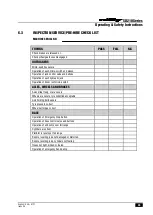
SD210 Series
Operating & Safety Instructions
English / USA – 07/11
Issue 06
35
4.8
TRANSPORTING, TOWING, CRANEAGE, STORAGE AND SETTING TO WORK
4.8.1
TRANSPORTING
If a work platform is to be moved over a longer distance, whether the machine is trailer mounted,
vehicle mounted, self propelled or tracked, the following procedure should be read before restraints are
attached to the machine. Cross loading is most frequently the cause of problems, as the method of
loading is no longer under the control of our own personnel. The recommendations made herein
should be passed on to subsequent carriers, such that the entire journey is carried out without incident.
•
Always ensure the truck or trailer you are loading or towing the Niftylift with can carry it legally.
•
If loading by crane the use of shackles and an adequately rated spreader beam, with four leg
slings around indicated slinging points on base, is
MANDATORY.
•
When loading or un-loading from the side of the vehicle, the use of the forklift pockets to retain
one of the forks is recommended. (If fitted). Spread the forks to their widest capacity, with
due regard to the components fitted to the machine. Never forklift or crane an entire machine
under the booms, always lift beneath the spine or under the ends of the axle mountings in the
case of a self-propelled unit. Ensure forklift is adequately rated for the load to be carried.
•
Once positioned on the transport carrier, ratchet straps should be used to secure the machine.
Pass the strap over the bosses located in the bottom of all four outrigger housings on the base
and secure to the transport carrier. The machine should be positioned to allow easy access
around the machine in transit, and to ensure that ‘creepage’ during transport does not permit
the machine to come into contact with other goods being shipped, or the container itself.
Some movement of the machine structure might occur during transit, which could lead to
fretting or other damage.
•
If the machine is equipped with a transit device such as a boom clamp etc, this should be
securely applied.
•
Strap booms carefully to constrain them from sideways movement. When using straps or
chains, adequate packing should be applied to stop any damage to the structure and
paintwork. Due regard of the movement of the straps or chains must be taken into account.
•
Where a machine has designated points for strapping, lifting or forking, these can be used for
tie-down duty. When they are absent, the major structure of the platform can be used, giving
due consideration to the design and function of the area chosen. Where possible, use the
spine of the machine or axle mounts over which to apply the holding down forces. Using a
single plate, such as an outrigger or stabiliser support plate might be unsuitable. If the
component was clearly not designed to accommodate a side load, one should not be applied.
•
Under no circumstances should straps or chains be applied over booms or through the cage
support structure or the cage itself. The relative strength of the carrying structure is not
conducive to the massive forces capable of being applied through ratchet chains or slings.
Severe damage to the steelwork can be caused, as well as deformation to sensitive
mechanisms such as cage weigh assemblies, which would render them useless. Such
catastrophic damage to say, an electronic load cell would require the component to be
replaced before the machine would function.










































